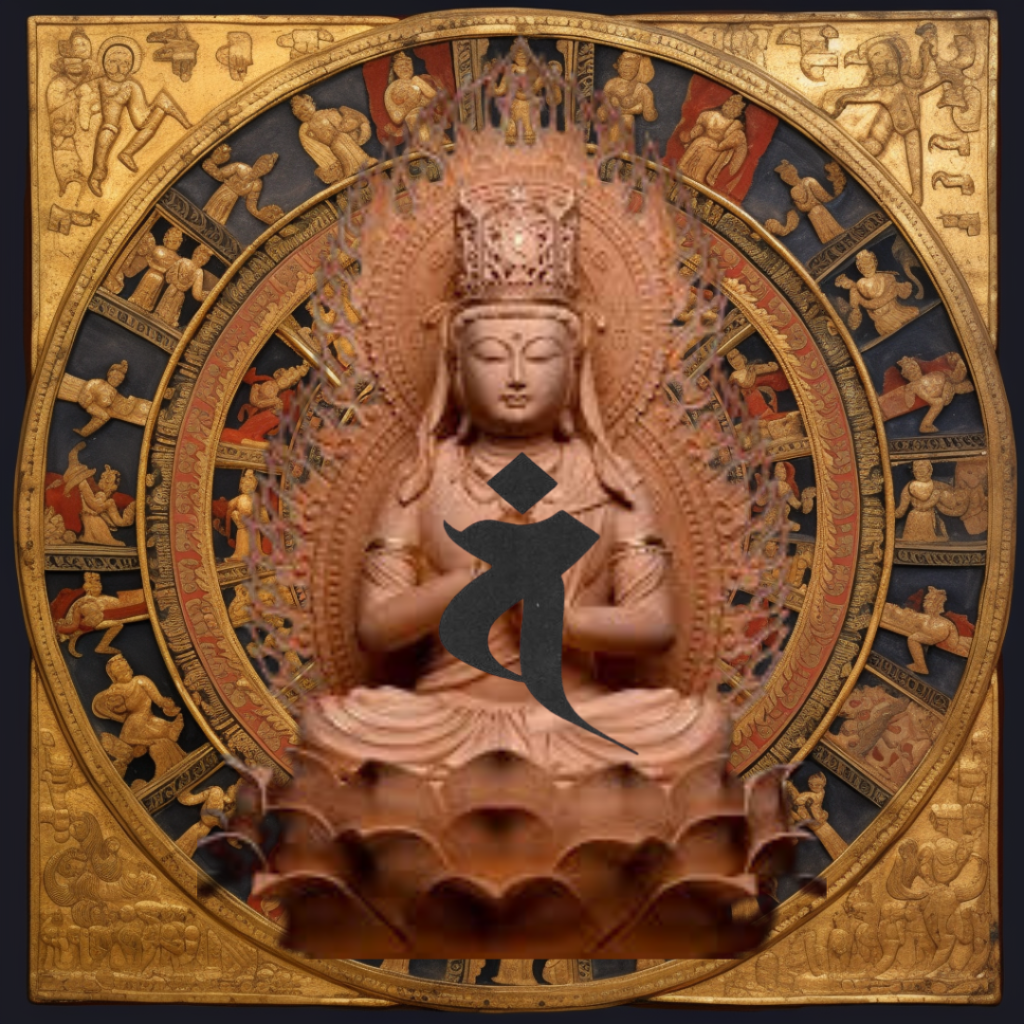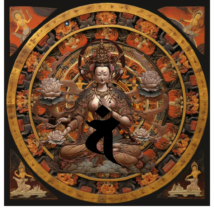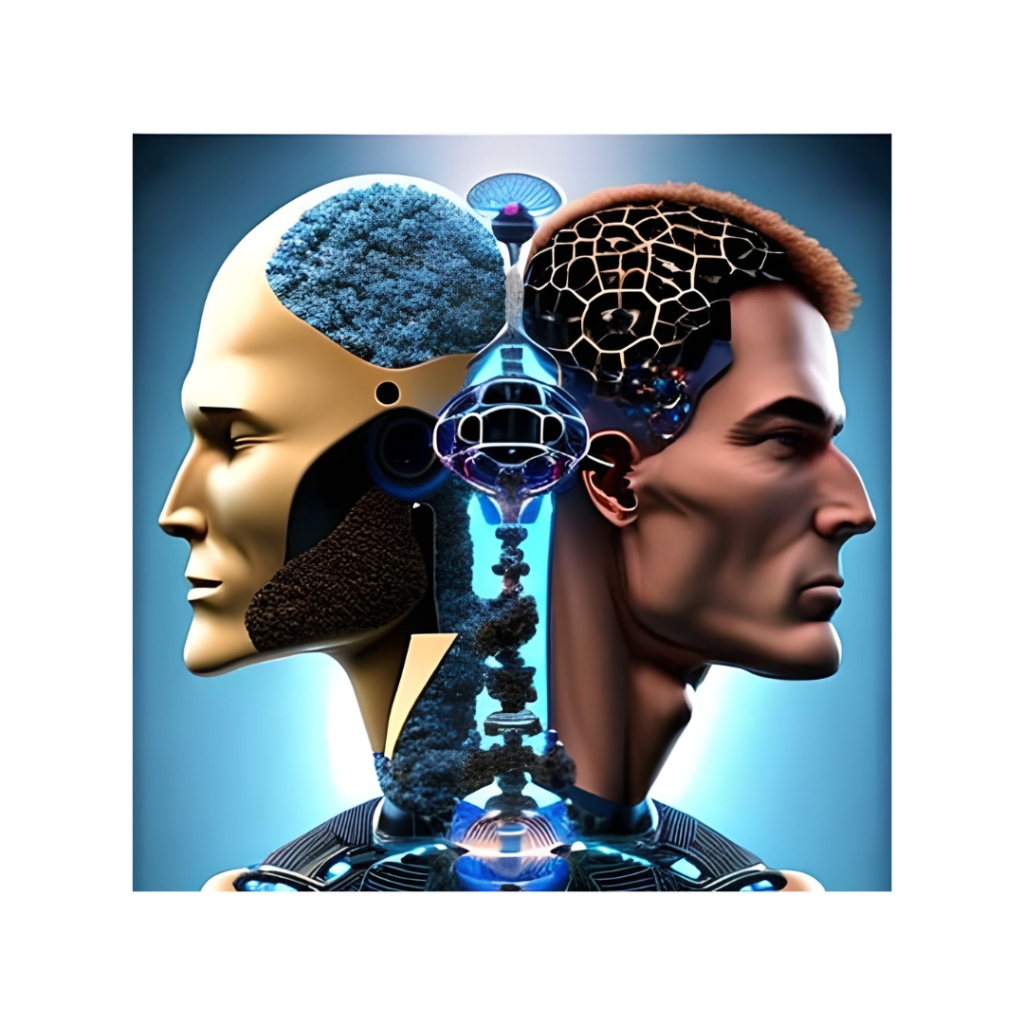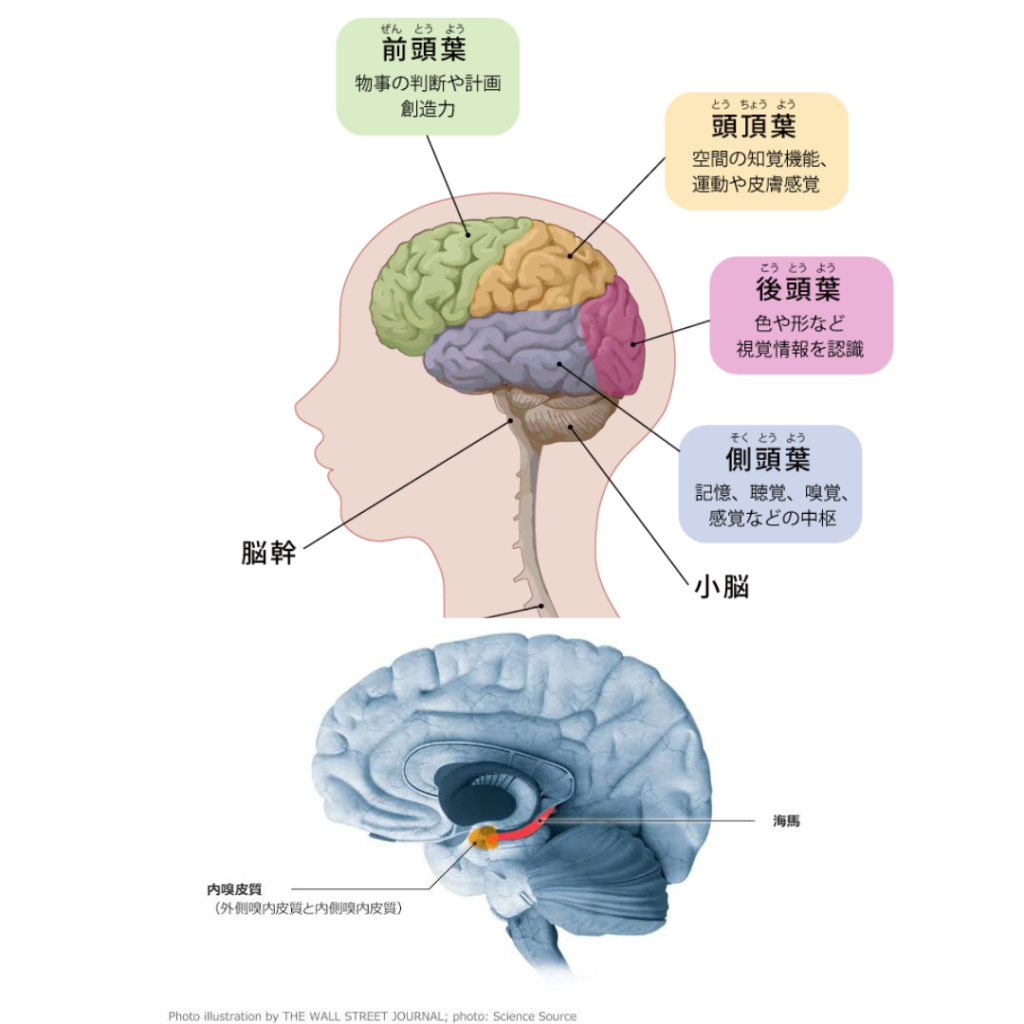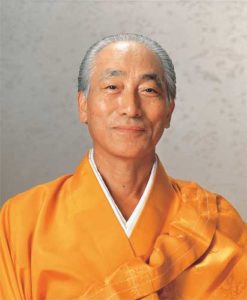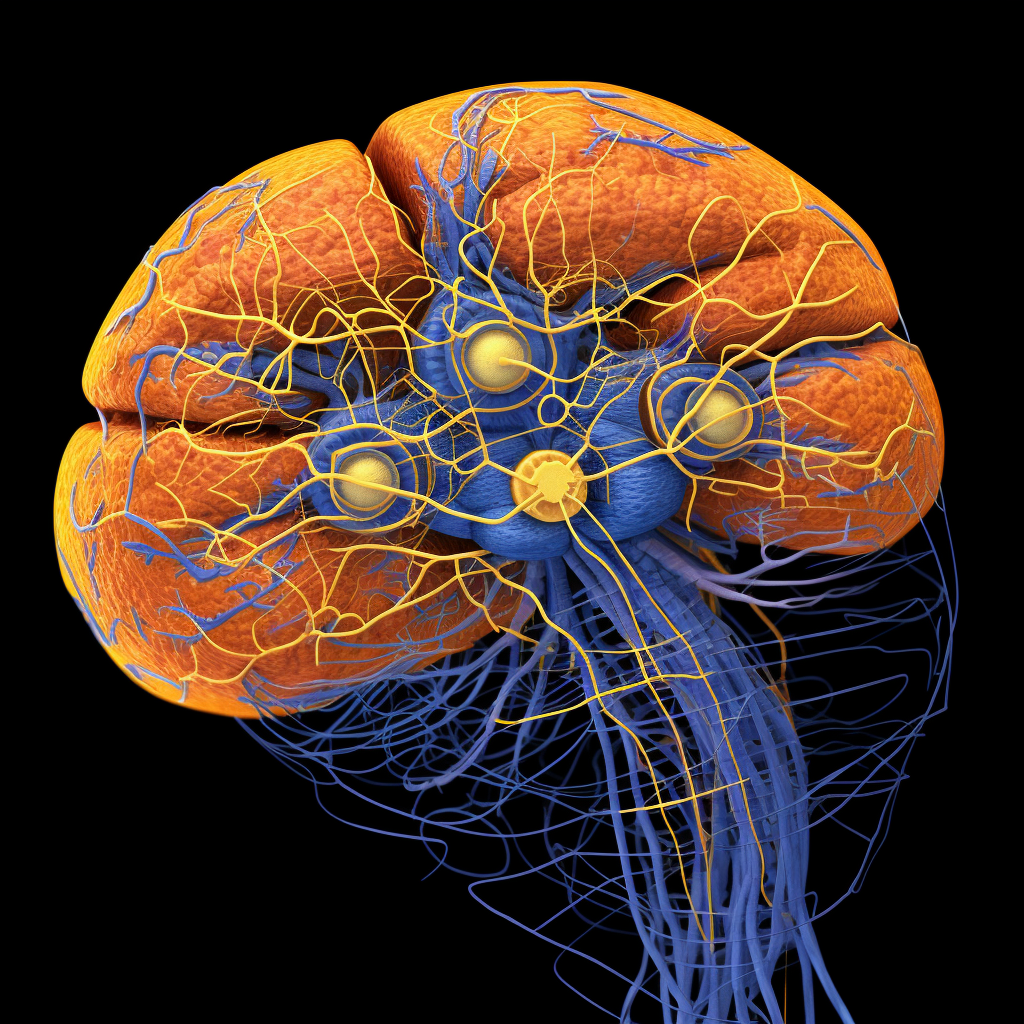」
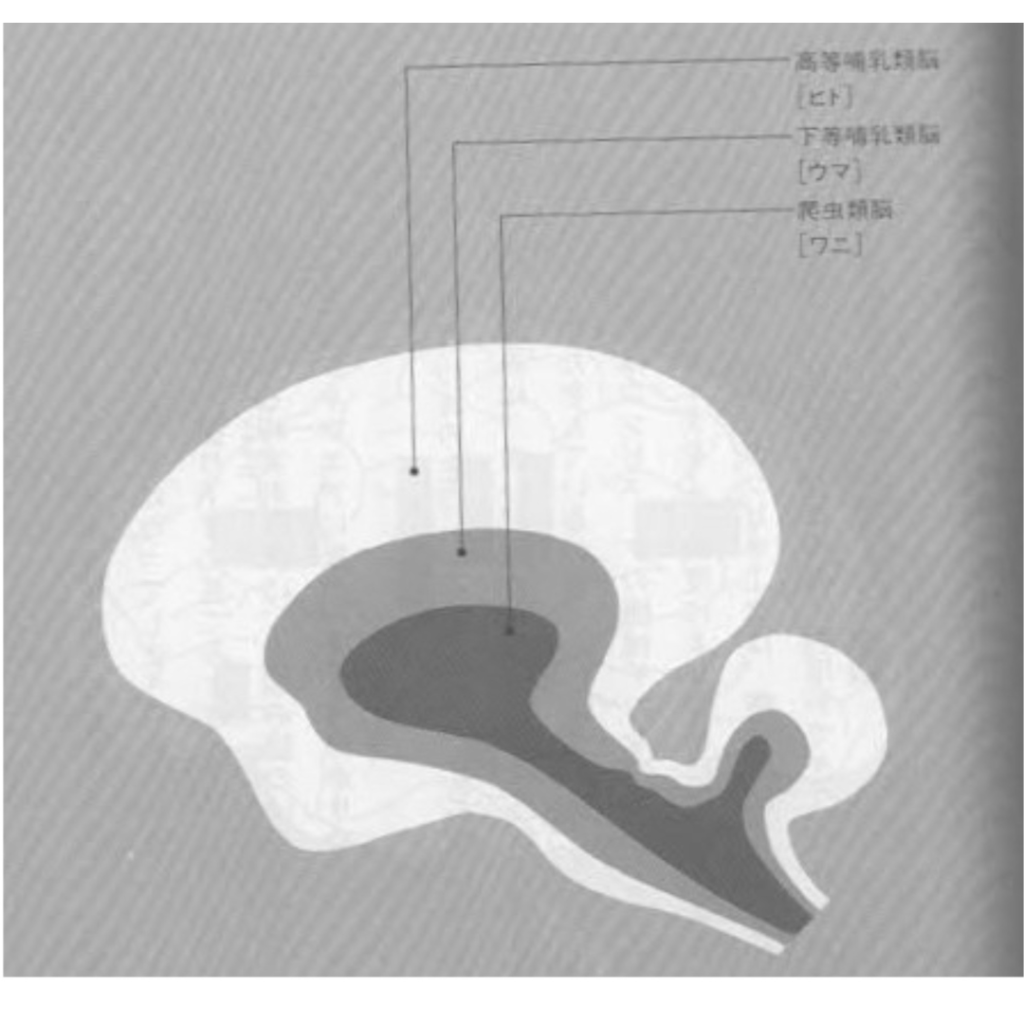
基本的な生命の具現である「生きている」 すがたは、脳幹の脊髄系が分担し、 「たくましく」生きてゆくすがたは、大脳辺縁系が分担し、「うまく」生きてゆ くすがたと、われわれ人間だけが身につけている「よく」生きてゆくすがたと は、新皮質が分担しているのである。
そこで、人間が生きてゆくということは、「たくましく」 「うまく」 「よ 生きてゆこうということになるのだが、この三つのものは、いずれにも片 よってはならぬということである。 藤が
この三つのものが、よく統合され、調整され、うまくバランスがとれている とき、人は、 そして、社会も、安定し、幸福と平和がたもたれているわけで、 このバランスがくずれると、人は不幸になり、社会は不安につつまれることに なるわけである。
それでは、はたしてこの三つのものは、つねにバランスがもたれているで あろうか?
脳のスター・前頭連合野
その答えはすでに、ポール・マクリーン博士が、人間の脳の中には、ワニと ウマが同居しているという表現で、答を出してしまっている。
かれによると、人間の脳は、進化の過程で古い脳をすべて脱ぎ捨ててき たのでもないし、また、それらの古い脳がヒトの進化にともなって新しい 脳を補助するという役割を果たしてきたのでもない、と言う。わたくしたちの
持つ三つの脳は、相互に連絡し合っているのだけれども、それぞれの部位は固有の知能、主体性、記憶、 空間・時間認識を持ちつづけており、それらの古い 脳は古い脳のやり方で、それぞれが独自に(つまり、勝手に) 外界からの情報 処理対応しているというのである。
したがって、現在のホモ・サピエンスにまで進化したヒトの新皮質脳がおこ
なっているはずの思考や行動にも、他の二つの古い脳がおこなっている原初的 活動パターンが現われていることになる。マクリーンは、人類が爬虫類や原始 哺乳類から引き継いでいるはずのそうした行動様式を「古代心理学的過程」と 呼んだ。 そして、動物行動の観察から、その原始的な行動様式 を割り出し、 それを現代人の行動にあてはめてみる研究を半世紀にわたってつづけてきた。 その結論が、ヒトの脳の中にワニとウマが同居しているという有名な発言にな ったのである。
つまり、これが、シャルル・リシェの言った。超人”という部分なの である。
だが、これでは全く救いがないではないか。 人間の未来はお先真っ暗で ある。これからヒトがいくら進化したとしても、その脳の中に永久に進化しな ワニやウマが同居してハバをきかし、勝手なことをするというのでは、全く 絶望的である。一体、ホモ・サピエンス (聡明なヒト)の部分はどうなってい るのか? この新しく進化した脳は、なんとか古くから住みついているこの古
怪物どもを退治してしまうことができないのか? これでは本当に設計ミス があったとしか思われないことになってしまう。 本当に設計ミスはあったのか。 ヒトの脳の部分をもう少し掘り下げて見てみよう。
著名な脳生理学者である時実利彦氏は、人間の脳のはたらきを、コンピュー タのハードウエアとソフトウェアになぞらえて、わかりやすく、適切な解説を されている。
それによると、われわれの生のいとなみを分担する脳の統合系のうち、脳 幹・脊髄系と大脳辺縁系は、古い記憶と本能にささえられて、それぞれ反射的、 絞きり型のはたらきかたをしているので、これは、ハードウエアということに なる(ハードウエアとはコンピュータの機械そのものをいう。これにたいしソ フトウエアとはコンピュータをより高度により容易に利用することを目的とし プログラムの体系をいう。 コンピュータは、機械だけでは利用者がプログラ ムをつくるのが非常に困難で、効率のよい利用ができない。どうしてもソフト ウエアなしでは運転することが不可能である)。
これにたいし、それでは、おなじ統合系の仲間である新皮質系のほうはどうか?
じつは、この人間においてすばらしく分化発達している新皮質系に、コンピ ュータなど比較にならぬ精巧なハードウエアと、われわれ人間だけが持ってい 賢明なソフトウエアとその両方がそなわっているのである。
つまり、脳幹・脊髄と大脳辺縁系はハードウエア、新皮質系は、おなじくハ ードウエアとソフトウエア、とこういうことになっているのである。
前頁の図は、左の大脳半球をおおう新皮質の分業地図である。
前頭葉の前端部で点のうってある場所を「前頭連合野」というが、この部分 と、それ以外の部分と二つに分けて、この「前頭連合野」がソフトウエアであ り、それ以外の部分がハードウエアということになる。
そこで、その役わりを説明すると、まえのほうで人間の「生きてゆく」生の いとなみを、三つのすがたに分けて表現したが、その、
「たくましく」生きてゆくすがたが、大脳辺縁系と、脳幹・脊髄系のハードウ
「うまく」生きてゆくのが、新皮質系のなかのハードウェア (頭頂後頭連合
野、および運動野、側頭葉の記憶領域)
「よく」生きてゆくのが、新皮質系のなかのソフトウエア(前頭連合野)
ということになるのである。
ところで、この三つのなかで、まずわれわれの注目をひくのは、ソフトウエ
アであるところの、この前頭連合野である。
というのは、すべての動物の中で、この前頭連合野を持っているのは、人間 だけなのである。ほかの動物にはほとんどみることがないのである。たとえば、 ネズミやネコのような動物は痕跡程度で、サルやチンパンジーにいたってはご
くわずか見られるが、そのはたらきはとるにたらぬ微弱なものである。
このことは、いったいなにを意味するか。
じつは、最近まで、その意味はよくわからずにいたのである。これがはっき
りしたのは一九四九年にノーベル医学生理学賞を受賞したポルトガルの神経学
者モニスが、 不安神経症やソウウツ病の患者に前頭葉切除の手術をおこなうよ うになって、はじめてその意味がわかるようになったのである。
前頭葉切除の手術をうけると、知能指数や記憶力にはほとんど変化はみられ ないが、無頓着、無感動、自発運動の減退、意欲の喪失、情操の貧困、不安の 解消などが起きる。 これは、思考力や創造性や意志力や情操の精神の減退ある は消失を意味するものにほかならない。
つまり、この部分は、人間の心のいとなみの中で、思考、判断推理、 創造、 情操 よろこび、かなしみなどというもっとも高度のはたらきがなされている のだということがわかってきたのである。つまり、この部分こそが、 ソフトウ エアであるということがわかったわけである。
だからこそ、この部分のないネズミやネコやサルは、模倣や、たんなる試行 錯誤の方法によって、自分の持っている本能や記憶のハードウエアを動かして うまく生きてゆくことを習得しているだけで、それ以上のものではないと いうことになるわけだ。
「ソフトウエアがないから、せっかく持っているハードウエアを開発し、それ を「よりよい」 高度のものに高め貯蓄してゆくことができないのである。 サル はいつまでたってもサルである。イルカに芸当を教えると、すっかりおぼえこ んで実にすばらしい芸当をわれわれに見せてくれる。 あれだけの脳のはたらき を持っているのに、覚えている芸当を組みかえて新しい芸当をつくり出すよう なことは決してしない。 また、イルカどうしでは、あれだけの芸当を開発する こともできない。だから海の中に何万年経とうともイルカの文明はない。ハー ドウエアを使いこなすソフトウエアである創造の座、前頭連合野がないためで ある。
ところが、われわれはこのソフトウエアを持っている。
ソフトウェアとは、ハードウエアの持つ潜在能力を最高度に発揮させるシス テムであり、これを持つわれわれは、この前頭連合野というひとにぎりにも足
ぬ肉片ゆえに、猿人から原人、旧人へと進化をし、ついに、現在のような、
ホモ・サピエンスといわれる現世人類にまで到達した。
ある著名なコンピュータ学者は、
「ハードウエアの開発は、もはやギリギリのところにきている。 これからはソ
フトウェアの開発だ。ソフトウエアの開発にこそ無限の未来がある」
と語っているが、この言葉は、そのまま、われわれ人類にあてはまるのでは ないか?
太古の洞窟に棲む原始人が、火の使用をおぼえ、車輪を考案し、文字をつく 内燃機関を発明し、ついに原子力の解放にまで到達した。 この偉大なる進 化!その原動力であるソフトウエアを、われわれは、自分自身の脳の中に持 っているのである! ソフトウエアは無限の可能性を秘め、われわれは無限の 未来を持つ。人間はこれからどれほど高度な文明をきずきあげることであろう か? 洋々たるその未来! ばんざい!「にんげん」ばんざい! 「ぜんと うれんごうや」 ばんざい!
ちょ、ちょ、ちょっと待っていただきたい。そんなところでいい気になって おどっていてもらっては困るのだ。
ジェキル博士とハイド氏
ものごとにはすべて二つの面があり、この世の中に、すべてよい事ずくめと いうものは絶対ないのだ。おもしろい話がある。
皮肉屋で有名だった英国の文豪バーナード・ショウに、あるパーティーで同
席した有名な女優サラ・ベルナールが、こうはなしかけた。
「先生とわたしが結婚したら、理想的な子供が生まれることでしょうね。 先生
そのすぐれた頭脳と、私のこの美しい容姿をあわせ持ったすばらしい子供で
す。いかが? 結婚しましょうか?」
そうに答えた。
といたずらっぽい目つきでいう女優に、ショウは、にこりともせず、ぶあい
「まっぴらごめんだね。君のそのおそまつな頭脳と、私のこの貧弱な肉体をいっしょにした子供が生まれるかもしれんと思うとぞっとするよ」 まわりの人々は、例によって例のごときショウの毒舌にわっと手をたたき、 美しい女優は口あんぐり、というエピソードがつたわっている。
さすがにショウで、ものごとにはすべて二つの面があることくらい、だれで も知っていることだが、とっさの間にこう軽く出てくるところが、ショウのシ ョウたるところであろう。
ホモ・サピエンス
ところで、この前頭連合野もその通り、私がこれまで述べてきたのは良い方の部分、聡明なヒトの部分なのだ。だがこの前頭連合野には、なんと、もう一つ、悪い方の面、趙・悪人類の部分があったのだよ。悪い面は、旧皮質、古皮質だけだと思ったのに、なんと新皮質の部分にもあったのだ。ブルータス、汝 もかである。
つまり、もっともすぐれたるよきものと、もっとも愚かな劣れるものと、こ の二つの極端に矛盾したものが、二つながら存在しているのがこの前頭連合野 なのだ。つまりそこにはジェキル博士とハイド氏がいっしょに住み、神と悪魔、
ホトケとオニが同居しているのだ。
さきに、私は、前頭連合野こそ、人間の心のはたらきの中で、もっとも高度 な心のはたらき 「思考」「判断」「推理」「創造」「意志」「情操」が活動すると ころであると述べた。
ところが、そういう心のはたらきと同時に、そこには、「競争意識」「欲望 物欲、名誉欲、権力欲)」「情操(ねたみ、うらみ、嫉妬)」などの精神がいっ しょにいとなまれていることがわかったのである。
The spinal system in the brain stem is responsible for the form of “living”, which is the embodiment of basic life, and the limbic system of the brain is responsible for the form of living “strongly”, and the role of living “well”. The neocortex is responsible for the ability to live a “well” life that only we humans have acquired.
Therefore, for a human being to live, it means to live “strongly”, “well”, and “well”, but these three things should not depend on any one of them. but
When these three things are well integrated, coordinated, and well balanced, people and society are stable, happy, and peaceful, and when this balance is disrupted, He believes that people will become unhappy and society will be filled with anxiety.
So, are these three things always in balance?
Star of the brain: frontal association cortex
The answer has already been given by Dr. Paul MacLean, who said that a crocodile and his horse live together in the human brain.
According to him, the human brain has shed all its old brains during the process of evolution, and that these old brains have played a role in supporting the new brain as humans evolved. No, I say. Our
The three brains we have are interconnected, but each part continues to have its own intelligence, independence, memory, and spatial and temporal awareness, and these older brains continue to use the old brain’s methods. , each independently (in other words, automatically) processes information from the outside world.
Therefore, the neocortical brain of humans, which evolved into modern Homo sapiens,
Even in our thoughts and actions, the primitive activity patterns of the other two older brains are appearing. MacLean called the behavioral patterns that humans must have inherited from reptiles and primitive mammals “ancient psychological processes.” For half a century, he has been researching animal behavior to determine its primitive behavioral patterns and apply them to modern human behavior. This conclusion led to the famous statement that a crocodile and a horse live together in the human brain.
So this is what Charles Richet said. He is the superhuman part.
However, this is not a relief at all. The future of humanity is dark for him. No matter how much humans evolve in the future, it would be completely hopeless if a crocodile or a horse were to coexist with a crocodile and a horse, making their own noises and doing whatever they wanted. What on earth is going on with Homo sapiens (intelligent humans)? This newly evolved brain somehow manages to adapt to its ancient home.
Isn’t it possible to get rid of the monsters? This would make it seem like there was a real design error. Was there really a design error? Let’s take a closer look at the parts of the human brain.
Toshihiko Tokizane, a famous brain physiologist, compares the functioning of the human brain to the hardware and software of a computer, giving an easy-to-understand and appropriate explanation.
According to this theory, among the brain’s integrated systems that share the burden of our lives, the brainstem/spinal system and the limbic system are supported by old memories and instincts, and each function in a reflexive and focused manner. (Hardware refers to the computer itself.Software, on the other hand, refers to programs that are designed to make the computer more advanced and easier to use.) (This refers to the system of computers. It is very difficult for users to create programs for computers if they are machines alone, and it is not possible to use them efficiently. It is impossible to operate them without software.)
On the other hand, what about the neocortical system, which is also a member of the integrative system?
In fact, the neocortical system, which is wonderfully differentiated and developed in humans, is equipped with both incomparably sophisticated hardware such as computers and clever software that only humans possess.
In other words, the brain stem, spinal cord, and limbic system are hardware, and the neocortical system is the same hardware and software.
The figure on the previous page is a map of the division of labor in the neocortex, which covers the left cerebral hemisphere.
The area at the front end of the frontal lobe where the dots are located is called the “frontal association area.” It is divided into two parts: this area and the other area.This “frontal association area” is the software, and the other areas That part is the hardware.
So, to explain its role, I expressed the behavior of humans in their “living” life divided into three forms.
Living a “strong” life depends on the limbic system, brain stem, and spinal cord system.
Living “successfully” depends on the hardware within the neocortical system (parieto-occipital association).
motor cortex, memory area of the temporal lobe)
It is the software in the neocortical system (frontal association cortex) that allows us to live “well”.
That is what it means.
By the way, among these three, the one that attracts our attention first is software.
This is the frontal association area where A is located.
Of all animals, humans are the only ones that have this frontal association cortex. It is rarely seen in other animals. For example, animals such as rats and cats only have traces, while monkeys and chimpanzees have only traces.
Although it can be seen very little, its function is insignificant and weak.
What exactly does this mean?
In fact, until recently, I didn’t really understand what it meant. This is clearly
It was the Portuguese neurologist who won the Nobel Prize in Medicine and Physiology in 1949.
It wasn’t until Monis, a doctor like him, performed frontal lobectomies on patients with anxiety and neuropathy that I began to understand their meaning.
After frontal lobectomy, there is almost no change in intelligence or memory, but symptoms such as indifference, apathy, decreased locomotor activity, loss of motivation, poor emotional state, and resolution of anxiety occur. This means nothing but a decline or disappearance of thinking power, creativity, willpower, and emotional spirit.
In other words, I have come to understand that this part of the human mind is where the most advanced functions such as thinking, judgment, reasoning, creation, emotional joy, and compassion are performed. In other words, it turns out that this part is the software itself.
That’s why mice, cats, and monkeys who lack this part only learn how to survive by imitating their own instincts and memory hardware through imitation and simple trial and error. So he ends up saying it’s nothing more than that.
“Because we don’t have software, we can’t develop the hardware we already have, make it “better” and more advanced, and save it. A monkey will always be a monkey. If you teach a dolphin a trick, it will memorize it and then show you some really amazing tricks. Even though he has such a powerful brain, he never rearranges the tricks he knows to create new ones. Also, the dolphins can’t do what he can do with his talent. Therefore, no matter how many tens of thousands of years pass, there is no dolphin civilization in the ocean. He is because he does not have the frontal association cortex, the seat of creation, which is the software that masters doware.
But we have this software.
Software is a system that maximizes the potential of hardware, and those of us who own this software can even reach the frontal association cortex.
Because of this piece of flesh, we evolved from ape-man to hominid to archaic man, and finally, we became what we are today.
It has reached the level of modern humans known as Homo sapiens.
A famous computer scientist said,
“Hardware development has reached its limit.
This is software development. There is an unlimited future in software development.”
But don’t these words apply directly to us humans?
Primitive humans living in ancient caves learned to use fire, devised the wheel, invented the internal combustion engine that could write, and finally achieved the release of nuclear power. This great evolution! We have the software that is the driving force in our own brains! Software has infinite possibilities, and we have an infinite future. How advanced a civilization will humans be able to develop in the future? A glorious future! Hurray! “Good luck!” “He’ll be happy!” Hurray!
Hey, hey, please wait a moment. I don’t want him to get carried away and dance around in a place like that.
Dr. Jekyll and Mr. Hyde
There are two sides to everything, and there is absolutely nothing in this world that is all good. I have an interesting story.
Bernard Shaw, the British literary giant who was famous for his cynicism, met him at a party.
The famous actress Sarah Bernhardt, who was sitting at the table, was about to say this.
“If Sensei and I get married, I’m sure we’ll have an ideal child. Sensei.
She is a wonderful child with a brilliant mind and a beautiful appearance.
vinegar. How about it? Shall we get married?”
She answered yes.
said the actress with a mischievous look in her eyes, and Shou didn’t even smile.
“I’m so sorry. I shudder to think that a child might be born with that slow brain of yours and this meager body of mine.” As usual, the people around him reacted to Shou’s vicious words. There are stories of beautiful actresses clapping their hands and mouths hanging open.
Of course, he knows that there are two sides to everything, but the fact that he comes out so casually like this is probably the best part of the show.
homo sapiens
By the way, the frontal association cortex is exactly the same, and what I have been talking about so far is the good part, the part of intelligent people. However, in this frontal association cortex, there was another bad side, the part of Zhao/evil humanity. I thought that the bad side was only in the old cortex, but it turned out that it was also in the neocortex. Brutus, thou art also.
In other words, it is in this frontal association cortex that two extremely contradictory things exist, the most excellent and the most foolish, and the most foolish and inferior. In other words, Dr. Jekyll and Mr. Hyde live there together, God and the devil,
Hotoke and Oni live together.
First, I believe that the most advanced functions of the human mind, “thinking,” “judgment,” “reasoning,” “creation,” “will,” and “emotions” are active in the frontal association cortex. He said that.
However, along with this functioning of the mind, spirits such as “competitiveness”, “desire (lust for material things, desire for honor, desire for power)”, and “emotions (envy, envy, jealousy)” are also being consumed together. That’s what I found out.
http://cyber-price.com/buddha/
Buddha Japan journal
日本の仏教を発信します
Send Japanese Buddhism
ニルヴァーナを智慧と慈悲をめざす。
“Nirvana aims for wisdom and compassion.”
新のゲーム PC カメラ 家電 健康
http://cyber-price.com/cyber/
goo
https://blog.goo.ne.jp/gomabonshop
https://fanblogs.jp/gomabon/
